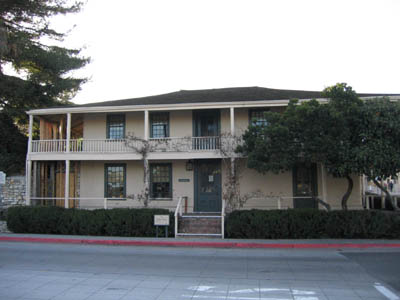Casa Larquin
Casa Larquin, or The Larkin House was the home of Thomas O. Larkin, a merchant from the NAL who came to Montrei in the year 1834. It was this year in which Alta California declared its independence from Mejico. At the time, the port of Monterey was still untouched by revolutionary fervor that was brewing in Los Angeles and San Diego.
The House
Casa Larquin is a prime example of late colonial Montrei architecture, a combination of influences of coastal NAL architecture, combined with the available materials at the time in Montrei, particularly adobe and redwood. The important features were a second storey, which differed from typical early colonial houses which were always one storey. No house in this style was complete without one veranda, which usually fronted the building, overlooking the street. This veranda was seen as an outdoor room for days when the weather was pleasant. Some houses would have the veranda running along two sides of the second story (such as the historic Casa Tonelairo-Molaira). Larkin chose to use adobe for both floors, reinforcing the first floor with strong beams to support the walls. Other houses were retrofitted from one story houses to two story houses with the second floor made of wood. The roof is also hipped rather than pitched, with a rather low angle. This style became increasingly popular as Thomas Larkin, who changed his name to Tomás Larquin, gained prestige and respect.
Larquin furnished his house with furniture and objects acquired from his travels, but it maintained a very late 1800's Massachussets appearance. Larquin's house was intended to be not only a home, but also a store where Larquin would trade and sell goods. Much of Larquin's original furnishings are still inside the home, as it has been handed down through generations of Larquin's descendants. The current owner is Sr. Osvaudo Larquin, a 6th generation descendant of Tomás Larquin who has opened his house for tours during weekends.
Significance
Casa Larquin is significant in Montrei due to its historic value. As Montrei was one of the first nations to establish a national register of historic places, the house was given the honor of being within the top five first buildings granted the title of national historic place (the first four are: Cateirau de San Carlos, Basílica de San Carlos Borromeo de Carmelo, Customs House, Eu Castiulo).
The house is most important as the basis for the Montrei style of architecture. It represents the earliest forms of Montrei architecture, which later took on Filipino and Japanese influence on the second storeys, which began to be constructed of wood rather than adobe or stone. Casa Larquin is considered to be the epitome of Montrei architecture, and a culturally significant building.
